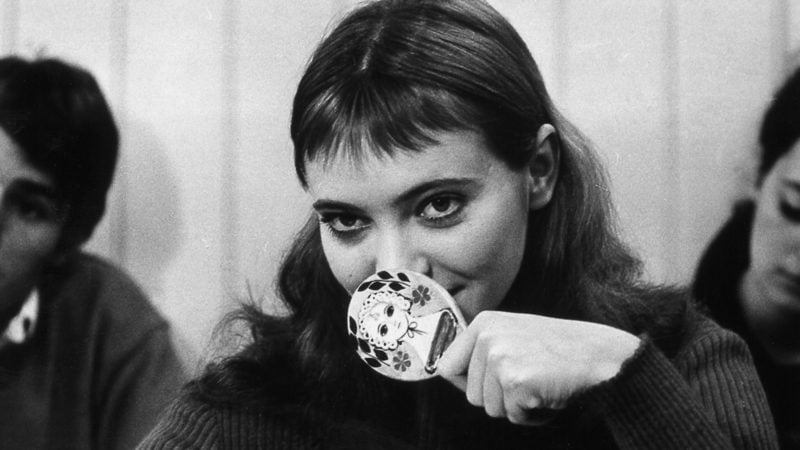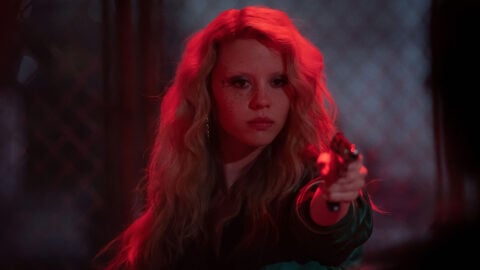Before the Revolution
This article appeared in the July 28, 2022 edition of The Film Comment Letter, our free weekly newsletter featuring original film criticism and writing. Sign up for the Letter here.

Band of Outsiders (Jean-Luc Godard, 1964)
1962…1963…1964, Film Forum’s exhilarating, unconventional slice of mid-century cinema, is fresher than any retrospective of the American Movie Renaissance (roughly ’67 to ’75). In 1962, four years before Stanley Kauffmann dubbed the movie-weaned audience “The Film Generation” and a decade before America’s film-schooled “Movie Brats” (Coppola, Spielberg, Scorsese) grabbed the world’s attention, moviemaking talent began popping up all over and moviegoing became a D.I.Y. adventure. Abetted by battling critical tour guides like Pauline Kael, Andrew Sarris, and Dwight Macdonald, cineastes scoured TV listings for obscure entries on The Late (or Late, Late) Show to cobble together their own playlists, and tumbled between art theater and grindhouse (where we might find Coppola’s 1963 horror film Dementia 13).
In its uninhibited eclecticism, the Film Forum series includes not just Sarris’s top auteur picks for each year—John Ford’s The Man Who Shot Liberty Valance (1962), Alfred Hitchcock’s The Birds (1963), and Jean-Luc Godard’s Contempt (1964)—but the subject of Macdonald’s supreme piece of highbrow film-crit, “8 ½: Fellini’s Obvious Masterpiece” (“the most brilliant, varied, and entertaining movie I’ve seen since Citizen Kane,” Macdonald wrote). Film Forum’s roster also contains a string of movies—Stanley Kubrick’s Lolita (1962), John Frankenheimer’s The Manchurian Candidate (1962), Martin Ritt’s Hud (1963)—that Kael singled out to support her contention that “there is more energy, more originality, more excitement, more art in American kitsch” than in Macdonald’s High Art. Kael also championed European art that made “complex experience simple and lucid,” citing, for example, Polanski’s Knife in the Water (1962)—and that’s here, too.
1962…1963…1964 echoes a compulsively readable and provocative book that flew under the radar during the pandemic: Cinema ’62: The Greatest Year at the Movies by Stephen Farber and Michael McClellan (who introduce, via Zoom, several entries in the series). They place 1962 at “the end of the studio era and before the full-blown emergence of the New Hollywood,” yet they treat that year not merely as a transition but also as its own Golden Age. Extending that idea to 1963 and 1964, Film Forum highlights the tumultuous social history and artistic innovation and mastery that triggered monumental change in the world’s moviemaking capitals.
This period starts with suave, literate President Kennedy galvanizing the young with calls for action on “the New Frontier,” and placing Ian Fleming’s From Russia with Love next to Stendhal’s The Red and the Black on his “top 10 books” list, boosting James Bond’s fortunes in America. The film adaptation of From Russia with Love, 1963—and then Goldfinger, 1964—popularized JFK’s choice with playfulness poised on the edge of camp.
While newspapers headlined the Cold War peaking with the Cuban Missile Crisis, a hot war unfolding in Vietnam, and the Civil Rights movement building to the March on Washington, Style pages covered the bold collages and comic-book quotations of America’s pop-art movement as well as the arrival of the miniskirt and the “Peacock Revolution” in menswear. This 35-film selection aims to demonstrate, with brio, that the heady glamour and political tumult of the Kennedy era, and the spontaneity and irreverence of contemporary art and design, inspired adventurous movies from veteran directors and tyros alike. These films seeded the ground for game-changers like Bonnie and Clyde (1967) and Easy Rider (1969); the “New Hollywood” that followed was, in commercial moviemaking terms, a revolution of modern and original ideas.
The American New Wave, beginning in the late ’60s, became known for upending or reviving genres, but it was directors near the start of the decade who ignited that iconoclastic movement. Martin Ritt’s hypnotic Hud transcended Hollywood categories. Was it a latter-day offbeat western? A mordant jeremiad on postwar avarice? A sex-charged comedy-drama centered on a cad in a Caddie (Paul Newman’s amoral, super-shrewd Hud, tagged in the ads as “the man with the barbed-wire soul”)? Or all three? In The Pink Panther (1963), Blake Edwards dropped Inspector Clouseau’s first slapstick eruption into a mock-elegant bedroom farce that also parodied caper films and the pretensions of the jet set.
This series lets us hop from nouvelle-vague high points—François Truffaut’s rhapsodic Jules and Jim (1962) and Agnes Varda’s unique, coruscating Cléo from 5 to 7 (1962)—to twin peaks of Italian cinema’s juicy satiric verismo, Alberto Lattuada’s Mafioso (1962) and Pietro Germi’s Divorce Italian Style (1961), and on to the British New Wave. Lindsay Anderson’s This Sporting Life (1963) showcases the primordial force of Richard Harris, who delivers the best Brando performance Brando never gave as a rugby player who finds clarity and purpose only on the field. John Schlesinger’s Billy Liar (1963) compensates for the miscasting of Tom Courtenay as an undertaker’s clerk who juggles two fiancées with the sensational casting of Julie Christie as the free spirit who hopes, in vain, to take him to London. She blows fresh air into a wheezing kingdom.
It’s astonishing, and elating, to realize how often the Anglo-American cultural exchange enriched international cinema. Cy Endfield, a blacklisted American expat, conjured the breathtaking British Army spectacle Zulu (1964). In the 1950s, studios exploited the 70mm format and the “cast of thousands” as a strategy to lure audiences back to theaters from television, but in Endfield’s hands they became tools of epic artistic expression: his shots of Zulu warriors descending on their foes in formidable waves haven’t lost their capacity to stun and amaze. Stanley Kubrick was a New Yorker in Britain when he razzed American mores and nuclear brinkmanship (respectively) in Lolita and Dr. Strangelove (1964). (Then he moved to England for good.) After JFK’s assassination, the Beatles snapped pop culture back to life with a catalytic youthful energy. Richard Lester, a Philadelphian in London, electrified the nascent youth movement when he captured, then and for all time, the Fab Four’s ecstatic anarchy in A Hard Day’s Night (1964).
1962…1963…1964 spotlights key works by young and old masters that fed into the emerging New Hollywood. The post–Bridge on the River Kwai David Lean achieved apotheosis in Lawrence of Arabia (1962) as he continued to make all the world his soundstage—just as Fellini in 8½ (1963), with gusto and inventiveness, made his soundstage all the world. Many of my own favorites brought high and low culture together in a free play of wit, craft, and intelligence, no ideological strings attached. Indeed, audiences still spark to the audacity of The Manchurian Candidate. Frankenheimer adopts techniques out of live TV and Hitchcock to satirize the threat of “brainwashing” from American media and McCarthyites as well as Marxist-Leninist-Maoist operatives. Unlike formula films, which date, movies as bold and individualistic as this one retain their tingling power.
It’s a shame that Bertolucci’s Before the Revolution (1964) didn’t make Film Forum’s cut, because this series levels the same implicit challenge as the Talleyrand quote that gave the movie its title: “Only those who lived before the revolution knew how sweet life could be.” 1962…1963…1964 enables those who lived during and after the cultural revolution of the late ’60s to mid-’70s to savor how sweet life and movies were before.
Omissions and Peaks
Among the marvels that didn’t make the cut: Sam Peckinpah’s magnificent send-off to the classical western, Ride the High Country (1962); Sidney Lumet’s Long Day’s Journey into Night (1962), one of America’s greatest pieces of filmed theater; Stanley Donen’s scintillating romantic-comic thriller, Charade (1963); Francesco Rosi’s seminal piece of you-are-there political cinema, Salvatore Giuliano (1962); and John Sturges’s rousing World War II POW film, The Great Escape (1963). But the series offers a parade of iconic actors in genre-bending, cross-cultural films:
Band of Outsiders (1964). The Jean-Luc Godard movie for people who hate Godard movies. With this daring hybrid of poetic frolic and real jeopardy, the writer-director turned Dolores Hitchens’s SoCal-set novel Fool’s Gold (1958), about three juvenile delinquents, into a kooky Parisian elegy for the fleeting romance of youth. Among the film’s quixotic splendors: Sami Frey and Claude Brasseur mimicking Pat Garrett and Billy the Kid; the two dancing the Madison with Anna Karina. Truffaut felt that with Frey, Brasseur, and Karina, “the highest degree of authenticity in acting has been reached.” What a lovely coincidence that Dolores Hitchens was married to the father of Film Comment founder Gordon Hitchens.
Alberto Sordi was the era’s scrambling Italian Everyman. He packs tragicomic punch in Vittorio De Sica’s frantic burlesque Il boom (1963) as a desperate arriviste who contemplates selling an eye to settle his debts. Sordi pushes his robust malleability to the limit in his must-see performance in the gutsy, groundbreaking Mafioso. As his character strives to please his kith and kin, Mafia included, Sordi conveys transporting nostalgia (in Sicily) and chilling homicidal proficiency (in New York).
Cape Fear (1962). Robert Mitchum’s Max Cady, the cool sexual sadist who gets at lawyer Sam Bowden (Gregory Peck) by terrorizing his wife (Polly Bergen) and pubescent daughter (Lori Martin), ranks with Mitchum’s psycho preacher Harry Powell in The Night of the Hunter (1955) for sheer looming menace. British director J. Lee Thompson (The Guns of Navarone), working for the first time on U.S. soil, turned John D. MacDonald’s all-American Gold Medal thriller The Executioners into a primal suspenser. He upended the father-knows-best certainties of sitcom families circa ’62. As Dwight Macdonald wrote of Mitchum in this character: “with the casual relaxation of Bing Crosby he breaches [their] defenses.”
Peter Sellers: the comic sensation of the ’60s, in three stellar showings. In The Pink Panther, Sellers invents Inspector Clouseau from an avalanche of deft touches, injecting four perfectly timed sight gags into one 50-second stretch. Before our own laugh-teared eyes, Sellers concocts a paragon of obliviousness and a magnet for misfortune. In Dr. Strangelove, with astounding aplomb, Sellers anchors the nuclear-apocalypse absurdity as (1) a pathetically ameliorating American president and (2) an earnest but ineffectual RAF officer. Then, as (3) the wheelchair-bound atomic scientist Strangelove, he soars into the black-comic stratosphere, struggling to keep a black-gloved right hand from executing a Nazi salute and unable to restrain his high-pitched Teutonic voice from addressing POTUS as “Mein Führer.” Sellers’s best film is Lolita: he hit his creative apex as Clare Quilty, the TV playwright who lures the title nymphet (Sue Lyon) away from the obsessed French-lit professor Humbert Humbert (James Mason). Sellers unleashes a portrait of the artist as a phony: he’s a quick-change genius using flaky, disarming disguises to rattle Humbert. No one improvises characters within a character as brilliantly as Sellers does here.
Sellers and these other standout actors are as responsible as their directors for the impudent, earth-quaking films that jolted us into a brave new cinematic world.
Michael Sragow, a Film Comment contributing editor, wrote Victor Fleming: An American Movie Master (Pantheon, 2008), edited two volumes of James Agee’s prose for the Library of America in 2005, and wrote and co-produced the 2019 documentary Image Makers: The Adventures of America’s Pioneer Cinematographers.







